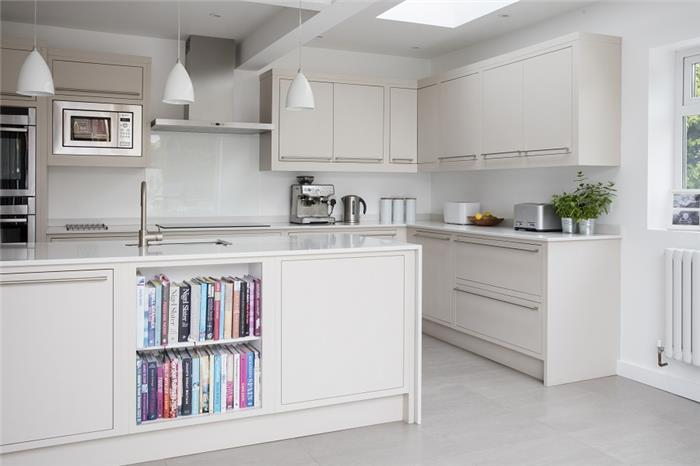Author: Site Editor Publish Time: 10-17-2025 Origin: Site








In cabinet design and manufacturing, material selection often determines both the lifespan and visual appeal of the final product. MDF (Medium-Density Fiberboard) and Plywood are two of the most widely used materials for kitchen cabinets. Both can produce beautiful finishes, yet they differ significantly in terms of structural strength, moisture resistance, and cost.
MDF, known for its smooth surface and paintability, is popular for modern-style cabinet doors and decorative panels. Plywood, on the other hand, offers superior durability, moisture resistance, and stability, making it ideal for high-use and high-humidity spaces such as kitchens. This article provides a comprehensive comparison of MDF and Plywood to help you choose the most suitable cabinet material for your project.
MDF is made from wood fibers and resin, compressed under high temperature and pressure into a dense, uniform sheet. Its smooth surface makes it ideal for painting, lacquering, or lamination, offering versatility in achieving sleek, modern cabinet designs.
Key Features:
High structural density and fine texture
No natural wood knots or grain direction, ensuring dimensional stability
Excellent surface finish for high-gloss, matte, or lacquer coatings
Prone to swelling when exposed to moisture

Plywood is composed of multiple thin layers of natural wood veneer, glued together with alternating grain directions. This cross-laminated structure forms a strong “layered system,” enhancing both strength and flexibility.
Key Features:
Layered structure provides high strength and toughness
Distinct natural wood grain texture
Excellent moisture resistance and reduced warping
Edges are rougher than MDF and require edge banding or surface finishing

Kitchen cabinets are exposed to weight, impact, humidity, and temperature fluctuations over time. In terms of mechanical performance, Plywood typically outperforms MDF.
Property | MDF | Plywood |
Bending Strength | 25–35 MPa | 40–55 MPa |
Internal Bond Strength | Moderate | High |
Density (kg/m³) | 650–800 | 500–650 |
Impact Resistance | Weaker | Stronger |
Average Lifespan | 8–12 years | 12–20 years |
Conclusion:
If your cabinets need to support heavy loads (e.g., stone countertops, kitchen appliances), Plywood provides better long-term stability and resistance to sagging or deformation.
MDF, however, is ideal for decorative panels and door fronts, offering refined texture and finish quality.
Kitchen and bathroom cabinetry often faces fluctuating humidity and occasional water exposure. Thus, a material’s moisture resistance directly affects its longevity and performance.
1. Material Absorption Mechanism
MDF: Though dense and uniform, MDF contains micro-fiber gaps that absorb moisture from the air. In high-humidity conditions, it may swell or bubble, especially with prolonged water exposure.
Plywood: The alternating grain direction in Plywood disrupts moisture paths, naturally improving resistance. When bonded with phenolic or waterproof adhesives, Plywood offers strong defense against water infiltration.
2. Moisture-Resistant Treatments & Engineering Enhancements
Moisture-Resistant MDF: Enhanced with waterproof resins or wax treatments to reduce absorption — suitable for cabinet doors, dry-area drawers, and wardrobe interiors.
Plywood Edge Sealing & Coating: Edge banding and waterproof coatings prevent moisture penetration, prolonging cabinet lifespan.
3. Application Recommendations
Area | Recommended Material | Description |
Under sink / near dishwasher | Plywood | Stable in humid environments, resists warping |
Dry-area drawers & doors | Moisture-resistant MDF | Smooth, paint-friendly, customizable |
Bathroom cabinets | Moisture-resistant Plywood | Durable under constant humidity |
Wardrobes & storage cabinets | Standard MDF or Plywood | Suitable for dry environments; choose based on budget |
From an engineering perspective, using Plywood for structural parts and MDF for decorative surfaces provides both moisture resistance and aesthetic appeal. Additionally, proper ventilation, sealed countertops, and sink edges can further extend cabinet lifespan.
Material Cost
MDF is typically 20–40% cheaper per square meter than Plywood, making it suitable for budget-conscious projects.
Plywood, especially waterproof or high-grade hardwood versions, is more expensive but significantly more durable.
Processing & Installation
MDF is easier to cut, shape, and finish — ideal for carving and lacquered surfaces with minimal waste.
Plywood is tougher and requires edge banding, resulting in slightly higher labor costs.
Long-Term Economy
MDF may swell or crack in humid environments, leading to potential repair or replacement costs.
Plywood, with superior durability and water resistance, offers better long-term value.
Application Strategy
Use Plywood for structural components (frames, base panels) for stability.
Use MDF for decorative parts (doors, drawer fronts) for visual appeal and cost control.
Summary: MDF is suitable for short-term or budget-limited projects, while Plywood is better for long-term, high-durability applications. Combining both materials strikes the best balance between cost, performance, and aesthetics.
Neither MDF nor Plywood is universally “better”; each serves different cabinet types and usage scenarios.
Choose MDF if you prioritize design flexibility, surface smoothness, and refined aesthetics.
Choose Plywood if you value structural strength, moisture resistance, and long-term performance.
Whether you’re looking for premium custom kitchen solutions or selecting materials for a commercial project, Summit provides comprehensive cabinet design and manufacturing support. With years of expertise in engineered wood applications, Summit can tailor cabinet systems that perfectly balance beauty, durability, and functionality according to your space, budget, and style needs.
Contact Summit today — let every detail of your space reflect the quality you deserve.